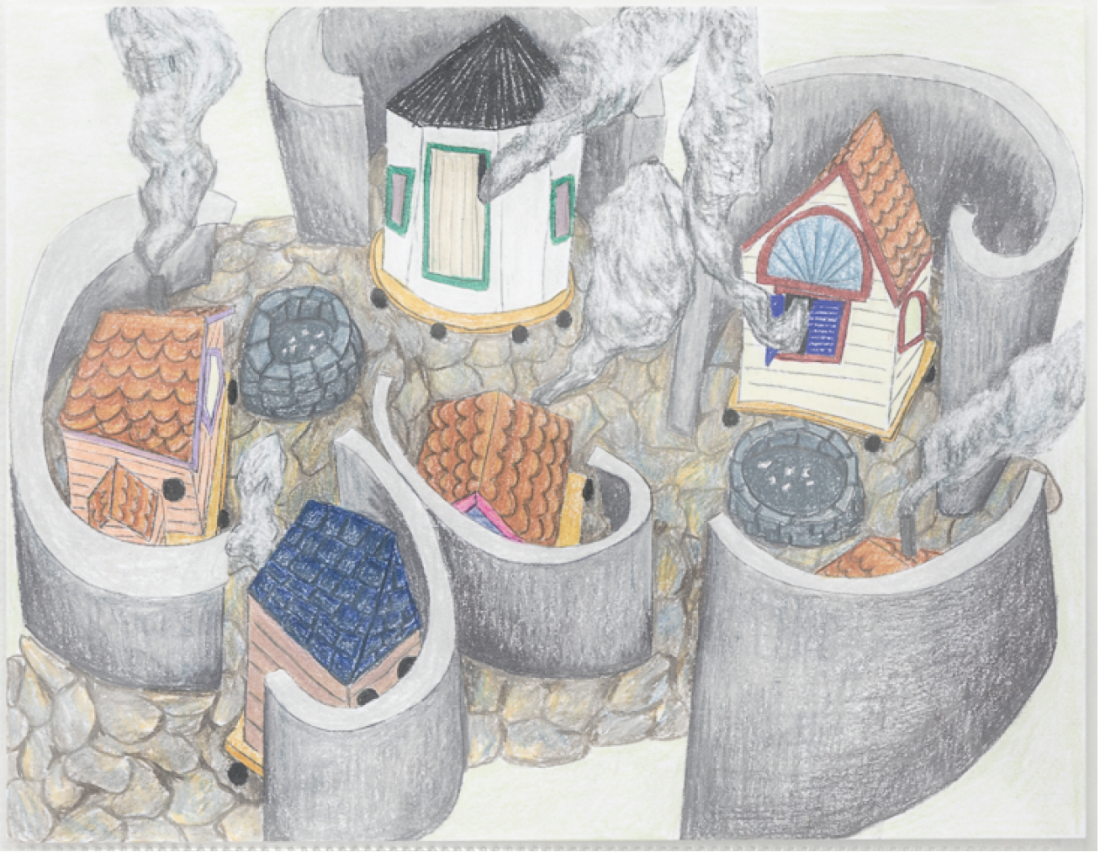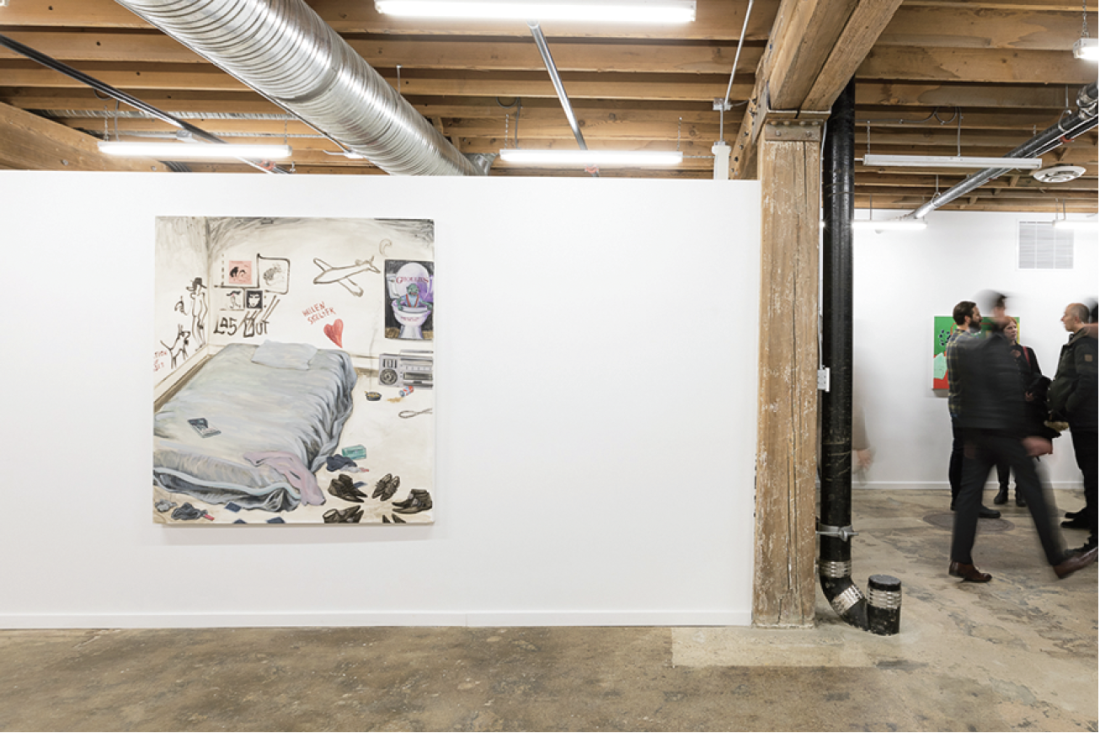“This Must be the Place (Home Pt. 2)”
A continuation of a prior exhibit that examined home as a localized geographical construct via Winnipeg, “This Must Be the Place (Home Pt. 2)” addresses the interior as a similarly significant space. At first, the work appears whimsical and cheeky, yet closer examination yields differing relationships to habitation: from nostalgia to embodied antagonisms of the built environment. The trio of artists in this exhibition is well paired, and aesthetic connections are made through pop-culture references, medium and a variety of scale.
Peggy Kouroumalos’s oil paintings populate the main gallery space at Lisa Kehler Art + Projects with exuberant angst. Through both intimate and large-scale works, Kouroumalos signals the materiality of adolescent identity. Head On (The Door), 2015, celebrates dark wave’s musical idols: Bauhaus, The Cure, Love and Rockets and Siouxsie Sioux, among others, are affixed to a closet interior in shrine-like adoration. I caught myself reminiscing about my own clusters throughout the years and their evolution from one room in a house that didn’t understand me to apartments in which I narrated every wall. For most teenagers, the bedroom is a coveted room of one’s own. It is a place of becoming where the possessions of the moment are thrown over childlike furnishings from the past. This feeling of becoming spills over to the neighbouring fictional book cover series (all 2015), triggering a secondary school book list that skews as a little edgy. Transformative texts include JD Salinger’s The Catcher in the Rye, William S Burroughs’s Junky and Henry David Thoreau’s Walden, to name a few. Kouroumalos tenderly articulates these covers with dappled brush streaks and hasty washouts that convey reimagined memories of youth with a fevered clarity stirred by literature. The impression is one akin to sharing or discovering something profound for the very first time.

Sherry Walchuk, Homes smoking, with windshields, 2017, pencil crayon on paper, 11.5 x 8 inches. All photos: Jacqueline Young. All images courtesy Lisa Kehler Art + Projects, Winnipeg.
Claire Milbrath draws on a palette that interrupts a childlike nostalgia with sly humour. She is described in the exhibition as “untrained” and influenced by painters such as Henri Rousseau and Seraphine Louis; her perspectives are off and surfaces appear naïve in the uneven application of paint. Her Goodnight Gray, 2016, clearly alludes to the childhood classic book Goodnight Moon in its vibrant contrasts of lime and scarlet alongside those signature drapes. The painting’s smattering of domestic objects and furnishings set the scene for a different bedtime story, which includes a figure she identifies as Mr. Gray, a homosexual character of her invention replete with wealth and ennui. Any sense of drama or tension between Gray and the other male figure in the painting is overwhelmed by the intense colour and further diffused by the decorative flatness of their surroundings. Another painting, Poor Gray on Chair, 2016, reveals Gray stiffly situated in a chair, again upstaged by Milbrath’s application of paint, which infuses the carpet below his feet with more depth than his vacant visage. Neither seems to reveal more about Gray or his surroundings, emptying out any grand relationship or perhaps undermining one between the master and his domain.
Sherry Walchuk dominates a smaller room in the exhibition space, furnished with a lovely dated sofa that enhances the embodied antagonisms at play throughout Walchuk’s delightful pencil crayon drawings on paper, each carefully displayed within their own home of protective plastic. She approaches her medium with a deft sensitivity, and it is easy to be charmed by the fantastical at a first glance. However, Walchuk’s depictions of personal homes within institutional homes offer a deeply moving humanistic approach to asserting the vulnerability of our own bodies and comfort within spaces. At home in a home, waiting for lunch, 2013, recalls Walchuk’s personal narrative of working in a senior care home as well as her relationship with her grandfather as he transitioned into one. At home in a home depicts a collection of cheerful homes atop individual dollys affixed with rear exterior handles to guide safe passage. Gathered around empty tables in a stark institutional interior, the bright trim and well-maintained roofs of the homes attempt to counter a sense of isolation. A similar tension of individual community and comforting space is represented with Homes watching EMDR TV, 2017. Eye movement desensitization and reprocessing (EMDR) is a psychotherapeutic treatment associated with PTSD. I find Walchuk’s careful attention to detailing each of the homes’ window treatments and roofing incredibly moving. Her suburban fortresses feel at once secure and fragile as they surround the screen in search of care.

Installation view, “This Must Be the Place (Home Pt. 2),” 2017, Lisa Kehler Art + Projects, Winnipeg.
Home as a place seems perpetually a space of becoming, with interiors and interiority in flux as we create and redefine our relationship to the systems of objects with which we surround ourselves. This domestic materiality—grounded in time as well as place in a cycle of nostalgia and renovation—deserves regular provocation and critical assessment beyond bricks-and-mortar associations of place. “This Must Be the Place (Home Pt. 2)” collectively suggests that our declarations of home as a place that is known, comforting and stable are on a continuum of habitation: one that is both remembered and discovered as we move through rooms that represent who we were, where we are or where we want to be. ❚
“This Must Be the Place (Home Pt. 2)” was exhibited at Lisa Kehler Art + Projects, Winnipeg, from March 24 to April 22, 2017.
Courtney R Thompson is an arts writer living in Winnipeg.

